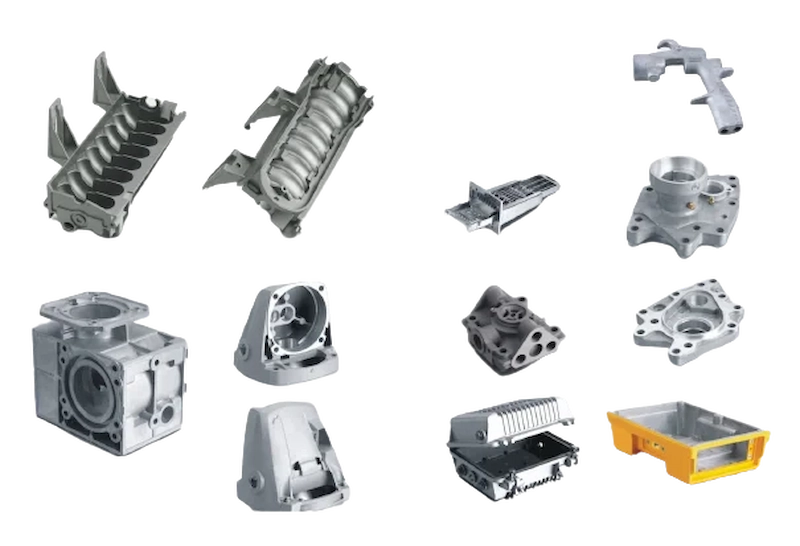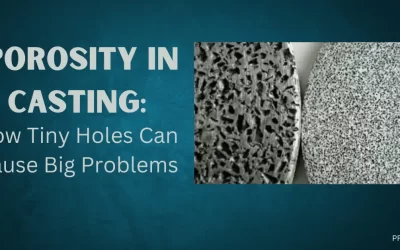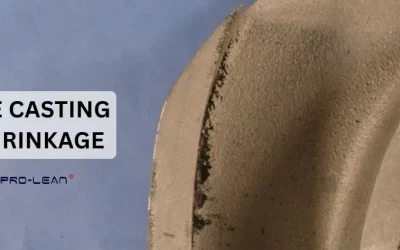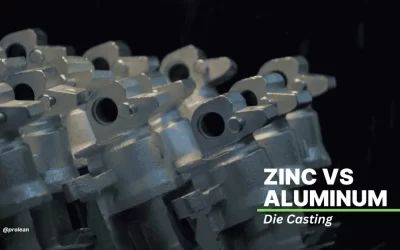“The low-pressure die casting enables the creation of intricate metal parts with accuracy and minimal waste – Exploring Low-Pressure Die Casting.”

The die-casting process can have two basic variations based on the pressure level while injecting the molten metal into the die. First, low-pressure die casting involves feeding the metal charge at low pressure, typically up to 0.8 bar. On the other hand, high pressure refers to feeding at a high-pressure level.
While both methods have distinct capabilities, low-pressure casting provides the best results for large, precise, complex parts with thin walls. We will then discuss LPDC die casting in detail, including the process, advantages, application, and more.
What is Low Pressure Die Casting?
LPDC(Low-Pressure Die Casting) is a metal casting process for precise and complex parts manufacturing, primarily using non-ferrous metals like aluminum. Unlike traditional casting methods, LPDC involves feeding or injecting molten metal into a mold cavity under low pressure. This technique gives better control over the metal flow, leading to high-quality castings with superior surface finishes and dimensional accuracy.

Low-pressure die casting
The significance of LPDC lies in its ability to produce parts with reduced porosity and enhanced mechanical properties. It benefits industries requiring lightweight and durable components, such as automotive and aerospace. Moreover, LPDC minimizes defects and ensures uniform part quality by controlling the injection pressure and cooling rates.
Furthermore, the efficiency and capability to manufacture complex parts with thin walls and intricate details make LPDC a preferred choice over traditional casting techniques. Overall, it offers a blend of quality, precision, and cost-effectiveness that is hard to match.
Related: What is Die Casting? Die Casting Process and Overview
Try Prolean Now!
The Working of Low-Pressure Die Casting
How does low-pressure die casting work? Low-pressure die casting combines physics with metallurgy to produce high-quality components. At its core, LPDC operates by injecting molten metal into a mold under low pressure. This method can fill molds with metal in a more controlled and gentle manner compared to high-pressure techniques. As a result, it significantly enhances the quality and integrity of the cast parts.

Working of low pressure die casting
The following elaborates on each step of the Low-Pressure Die Casting Process, detailing its procedure.
1. Melting Metal Alloy in Furnace
First, the desired metal alloy is heated until it reaches its specific casting temperature. This temperature is calculated based on the alloy’s melting point, ensuring the metal is fully molten and ready for casting. The precision in this step is crucial, as it directly influences the fluidity of the molten metal, affecting the quality of the final cast part.
2. Transferring Molten Metal to the Holding Furnace Below the Mold
Once the alloy is molten and at the optimal temperature, it is transferred to a holding furnace, which is located directly beneath the mold. This strategic positioning is vital for maintaining the metal at a consistent temperature, ready for the casting process. The holding furnace acts as a buffer and makes the molten metal’s temperature stable so that there is a steady supply for the casting.
3. Forcing Molten Metal Through a Riser Tube into a Mold
The essence of LPDC comes to light in this step. The molten metal is gently forced through a riser tube into the mold by applying low pressure, usually below 0.8 bars. This low pressure provides a steady flow of metal into the mold cavity. Therefore, it minimizes turbulence and the risk of air entrapment. Meanwhile, the pressure is maintained throughout the solidification process to ensure complete mold filling and to compensate for metal shrinkage.
4. Solidifying the Metal Under Constant Pressure
As the molten metal fills the mold, it begins to cool. Solidification starts once the metal temperature drops below its melting point. This crucial phase occurs under constant pressure, which helps fill the mold cavities as the metal contracts. Subsequently, this step is instrumental in reducing casting defects and ensuring a uniform internal structure.
5. Releasing the Pressure
After the metal has fully solidified within the mold, the pressure released facilitates further procedures. If some molten metal remains unsolidified, it is collected and recycled, minimizing waste and maximizing resource efficiency.
6. Cooling the Mold and Part Removal
The final step involves cooling the mold to facilitate the removal of the cast part. Proper cooling completes the solidification process and enhances the part’s structural integrity. Once the mold is sufficiently cooled, the mold opening and part removal give the final part.
Advantages of Low Pressure Die Casting
The following are the critical advantages of LPDC in metal parts manufacturing;
- It can achieve exceptional accuracy through consistent, low-pressure injection into the die cavity.
- A negligible presence of slag ensures the production of remarkably pure castings.
- The process’s compatibility with various non-ferrous alloys adds to its adaptability to diverse industrial needs.
- The process enhances the molten metal’s fluidity, facilitating the creation of intricate shapes.
- The LPDC involves dense crystallization, which results in robust, durable parts fit for rigorous use.
- Low-pressure die casting also augments the mechanical strength of the end product,
- Since liquid metal enters into the mold with less turbulence, there is a low risk of oxidation and porosity. So, it produces parts with smoother surfaces and more defined shapes.
Disadvantages of Low Pressure Die Casting
Talking about cons, LPDC has some limitations and possible defects regarding the die casting metal parts;
- It is mainly suitable for casting non-ferrous metals, such as aluminum and magnesium, limiting its use with ferrous materials.
- The initial setup and equipment costs for LPDC could be higher than other casting methods.
- Due to the lower pressure and careful control, it often has a slower casting cycle than high-pressure die casting.
- There are practical limits to the size of components with low pressure die casting process.
Try Prolean Now!
What are the Low Pressure Die-casting Products?
The Low-pressure casting approach is predominantly usable for non-ferrous metals like aluminum and magnesium. Meanwhile, its ability to produce high-quality, precision components with excellent material properties makes low-pressure die casting applicable in many industries.

Low pressure die casting part
Here are 20 products commonly manufactured using Low Pressure Die Casting:
- Automotive wheels
- Engine blocks
- Transmission cases
- Brake calipers
- Suspension components
- Aerospace structural parts
- Satellite frames
- Lighting fixtures
- Heat sinks for electronics
- Electronic enclosures and chassis
- Frames for large machinery
- Pump and valve bodies
- Marine outboard engine parts
- Sporting goods (e.g., golf clubs)
- Medical components and devices
- Agricultural machinery parts
- Household appliance components (e.g., oven doors, fan blades)
Low-Pressure Aluminum Casting: The Best LPDC Application?
Primarily, Low-pressure aluminum casting is a major/best application due to aluminum’s inherent properties and the specific advantages offered by the LPDC process. Aluminum provides lightweight, high strength-to-weight ratio, and excellent corrosion resistance. Its dominance in low-pressure die-casting applications is due to several factors.
- Firstly, aluminum’s lower melting point than ferrous metals makes it ideal for casting, reducing energy consumption and the risk of thermal degradation to the equipment.
- Additionally, aluminum alloys offer exceptional fluidity, allowing for the production of complex shapes and intricate details without compromising the quality.
- This metal also exhibits remarkable corrosion resistance, ensuring durability and longevity in the final products.
- Lastly, the lightweight nature of aluminum contributes significantly to industries such as automotive and aerospace.
When to use Low Pressure Over High Pressure Die Casting?
The low-pressure die casting is preferred when high levels of accuracy and superior surface quality are essential. This method excels for parts with complex geometries or with minimal internal porosity. Consequently, it is ideal for automotive and aerospace components because they demand precision and structural integrity. Meanwhile, the controlled filling process of low-pressure die casting reduces the likelihood of defects, ensuring a higher-quality finish.

Aluminum low pressure die casting parts
In contrast, high-pressure die casting is known for its rapid production capabilities and suitability for large volumes of smaller and thinner-walled parts. However, low-pressure die casting becomes the method of choice when the application requires larger and more intricate components with superior mechanical properties.
Table: LPDC vs. High-Pressure Die Casting
| Feature | LPDC | HPDC |
| Pressure | Up to 0.8 bar | Above 1000 psi |
| Porosity | Lower | Higher |
| Surface Finish | Superior | Good |
| Cost | More cost-effective for certain products | Higher due to faster cycle times |
Furthermore, the low-pressure die-casting process is more cost-effective for medium to low-volume productions due to its longer mold life and reduced material wastage. The process allows for large parts manufacturing with less stress on the mold. It extends the lifespan and decreases per-unit costs over time. Additionally, the ability to recycle and reuse the molten metal directly from the holding furnace contributes to the efficiency and sustainability of the process.
Try Prolean Now!
Which Metals Can Be Cast with Low-Pressure Die Casting?
This method is mainly suitable for metals with good flow characteristics and relatively low melting points. So, you can create components with intricate designs, superior surface finishes, and minimal defects. Subsequently, metals commonly used in low-pressure casting are aluminum, magnesium, and copper alloys. Here, each one offers unique properties and advantages for specific applications. However, the choice of metal depends on the desired mechanical properties, corrosion resistance, weight, and cost considerations.
1. Aluminum
It is an extensively used metal in low-pressure die casting due to its excellent flowability, lightweight, and corrosion resistance. Furthermore, aluminum alloys provide a high strength-to-weight ratio that makes them suitable for automotive, aerospace, and consumer electronics applications. Components like engine blocks, wheels, and frames benefit from aluminum’s ability to produce lightweight, durable parts. Furthermore, aluminum’s thermal conductivity makes it suitable for heat exchange applications.
2. Magnesium
It is another common choice for LPDC, the lightest structural metal. Its alloys are renowned for their low density, high strength-to-weight ratio, and excellent damping characteristics. Magnesium is often used in automotive and aerospace industries to reduce weight without sacrificing performance. Parts such as gearboxes, seat frames, and electronic housings are typically cast from magnesium alloys to leverage their weight savings and material properties.
3. Copper Alloys
Copper alloys like brass and bronze are other popular materials in low-pressure die casting due to their superior electrical and thermal conductivity. These metals are chosen for components that require high wear resistance and excellent electrical Subsequently, the applications range from electrical connectors and heat sinks to decorative items and bearings.
The Low Pressure Die Casting Cost
The cost associated with low-pressure die casting (LPDC) is influenced by several factors. Meanwhile, each factor plays a crucial role in the final expense. The common factors such as the part’s size and complexity, the metal used, production volume, and quality standards directly impact costs. Additionally, the specific equipment and setup required for LPDC, although generally less intricate than that needed for high-pressure die casting (HPDC), still represent significant investments. According to my engineering experience:
“I can say that low-pressure die casting is a more economical option than HPDC. But, it is only for projects where high quality and reduced porosity are essential.”

Custom die cast component
Subsequently, the process’s efficiency in using molds and its ability to produce near-net-shape parts with minimal finishing requirements contribute to cost savings. Moreover, initial investments for LPDC machinery can range between $20,000 to $50,000. It is considerably lower than the costs for HPDC machinery. This low cost is valid, even if there is a need for complex die-shot systems and their maintenance. Next, the cost per piece in LPDC also varies like the initial cost, from as low as $1 to several thousand dollars based on the project’s specifics.
Read more:
- Aluminum Die Casting Manufacturer for Your Metal Parts
- Revolutionizing Die Casting with Xiaomi’s Super Large Die Casting Technology
Summing Up
This die casting method with low injection pressure is a key way to create various metal parts for diverse applications. Subsequently, the low-pressure die casting creates robust and accurate parts from metal and alloys with lower melting points, such as aluminum and magnesium. However, precise execution of each step and some considerations are crucial to achieving quality cast parts.
If you are looking for quality die casting services, ProleanTech is the best choice! We have been providing related services for diverse industries for the last decade. Our services blend the experience and advanced die-casting facility to meet your needs!
FAQs
What are the common materials in LPDC?
Primarily aluminum alloys due to their excellent flow characteristics and low melting points.
How does LPDC differ from traditional casting methods?
LPDC uses lower pressures that can lead to higher quality finishes and less porosity than high-pressure methods.
What are the key advantages of LPDC?
The advantages of low-pressure die casting are superior surface finish, reduced porosity, and cost-effectiveness for specific applications.
Can LPDC be used for small production runs?
Yes, although it’s more cost-effective for medium to high volume productions due to the initial setup costs.
How does LPDC impact the environment?
It’s generally considered more environmentally friendly due to lower energy consumption and longer mold life.
What industries benefit the most from LPDC?
The industries most common are; automotive, aerospace, consumer electronics, and home appliances industries.
Resources
- Mallick, P.K. (2020). Materials, Design and Manufacturing for Lightweight Vehicles (2nd ed.). Woodhead Publishing in Materials. https://www.sciencedirect.com/book/9780128187128/materials-design-and-manufacturing-for-lightweight-vehicles




0 Comments